Fecal Transplant: An Amazing Cure You’ve Probably Never Heard Of
Dr. Margo Roman is using this admittedly gross therapy to heal a wide range of stubborn diseases in pets, including digestive disorders, behavior problems, itchy skin, and coprophagia (poop eating).
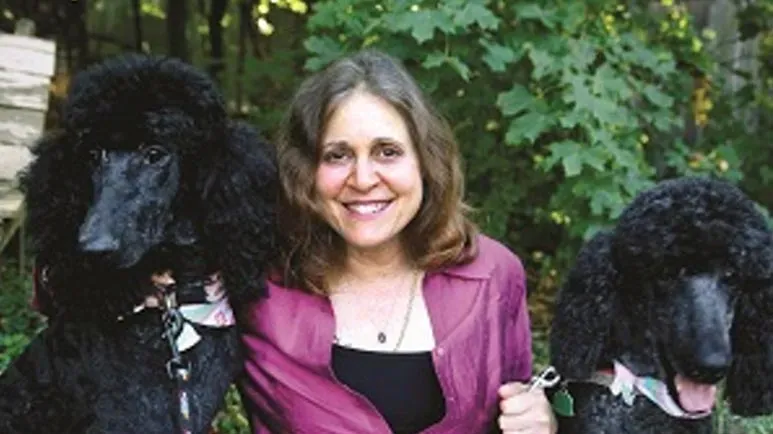
STORY AT-A-GLANCE
- Dr. Margo Roman, an integrative veterinarian who offers many cutting-edge alternative therapies at her practice in the Boston area, discusses microbiome restorative therapy, also known as fecal transplants
- A fecal transplant is just what it sounds like. Poop from a healthy animal is introduced into the body of an unhealthy animal
- Dr. Roman has used fecal transplants to successfully treat dogs and cats with a wide variety of conditions, including severe gastrointestinal disease, behavioral issues, atopic dermatitis, and coprophagia (poop eating)
Editor's Note: This article is a reprint. It was originally published December 13, 2015.
Today, I’m talking with Dr. Margo Roman, a fellow integrative veterinarian and owner of Main Street Animal Services of Hopkinton (MASH), which is located in the Boston area.
Dr. Roman offers many cutting-edge alternative therapies to her patients, and today I want to talk to her about an exciting treatment called microbiome restorative therapy, also known as a fecal transplant.
Dr. Roman learned of the therapy while reading an article about a medical doctor who was treating a patient with Clostridium difficile (C. diff), a potentially devastating intestinal bacterial infection that kills about 29,000 people in the US each year.
The C. diff patient in the article was down to about 80 pounds and close to death. According to Dr. Roman, the MD, “[t]ook a sample of the patient’s husband’s feces, put it in a blender, and then gave it to the wife through a nasogastric tube.”
Within two days, the patient was having normal bowel movements and made a complete recovery. The MD performed the same procedure on over 100 C. diff patients, and 97% had a successful recovery with just one treatment.
Dr. Roman thought to herself, “Dogs eat poop anyway. I wouldn’t be doing anything that they don’t already do — I’m just directing them towards the right poop to eat.”
Dr. Roman’s First Fecal Transplant Patient Was a Dog Named Stovin
Dr. Roman read that article over 10 years ago, and afterwards she kept telling herself, “I should just do it. I should just give a dog poop from my healthy dogs and see what happens.” Finally, she did her first case. It was a standard Poodle whose owner had spent over $16,000 attempting to treat severe gastrointestinal problems and Addison's disease.
The dog, Stovin, was so emaciated, he had to be carried into her clinic. He was hemorrhaging from the gut, and no one knew why. Dr. Roman treated him with acupuncture, ozone therapy, and a fecal transplant, and Stovin made a complete recovery.
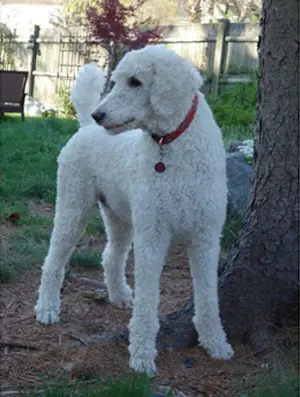
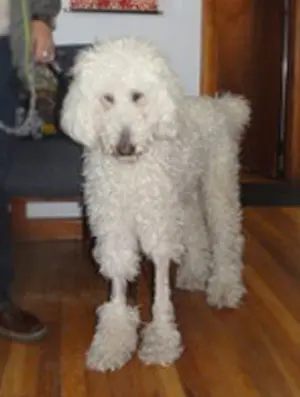
Dr. Roman realized with the success of Stovin’s treatment the huge potential for microbiome restorative therapy. Stovin had been on multiple rounds of antibiotics and other drugs, had been treated for bladder infections, and on and on. After the fecal transplant, all he needed was medication for Addison’s disease and his new fresh food diet.
Dr. Roman uses poop from her own dogs because they’ve never been given antibiotics and they eat only raw, fresh, and organic foods. Her home is green and sustainable, and she has never used herbicides or pesticides in her home or on her pets. She feels the cleaner a dog has lived, the more powerful the immune effects of their biome.
Heartworm Preventive Triggers Archie’s Aggression
Another patient of Dr. Romans who received the therapy was a wire-haired fox terrier named Archie, who lives with his littermate, Agatha. Archie has an immunoglobulin deficiency, and he has always been aggressive toward his sister Agatha. He would stand on her and dominate her, and just generally behave like a mean, anxious dog.
Dr. Roman gave Archie a fecal transplant, and 24 hours later he was licking and grooming his sister, which is something he had never done. He was able to eat foods that had always given him diarrhea in the past. His anxiety disappeared, and he was calm and balanced.
Two and a half weeks after the fecal transplant, Archie was given the drug Interceptor for heartworm prevention. Both Interceptor and Heartgard are antibiotics. The day after getting the Interceptor, Archie ripped into Agatha and they both ended up at an animal hospital with fight wounds.
Archie received another fecal transplant after he was healed from the fight, and he returned to his desirable behaviors of licking, grooming, and playing with Agatha. Something about the adjustment in Archie’s gut flora caused by the transplant changed his temperament and his digestion for the better. He’ll no longer be given Interceptor, and Dr. Roman says it’s important to remember that all monthly heartworm preventives are antibiotics.

This made Dr. Roman realize how fragile the gut microbiome can be — that a heartworm pill could completely disrupt the balance of bacteria in the gut. These days, she’s very careful about giving heartworm preventives. With her own dogs, she collects a stool, keeps it for 24 hours, gives the dogs a low dose of heartworm preventive, and then gives them a fecal transplant (with their own poop). “I can’t afford to lose their biome with a heartworm pill,” says Dr. Roman.
Itchy, Miserable Mojo Receives Fecal Transplant
Dr. Roman has successfully treated a number of other behavior cases with microbiome therapy, for example, Mojo the cat.
Mojo had been neutered as a young kitten, so his body had no hormone exposure to speak of. He had developed severe atopic dermatitis, with scabs all over his face. He had been to veterinary allergists and dermatologists, had been given cyclosporine, steroids, and antibiotics for two years, and nothing helped. Mojo was an angry, miserable 7-year-old cat.
Dr. Roman used her cat, Trapper, as the poop donor. Trapper is raw fed and wasn’t neutered until he was a year old. Mojo received the fecal transplant from Trapper (a week after he was neutered) and also ozone therapy to reduce the biofilm and support his immune system. Within 2 days Mojo stopped itching and his coat was coming back in. In two weeks he was no longer itchy or scratching, and was feeling much happier about life.
In fact, Mojo was so much better that six weeks later his mom made the two-hour round trip to collect two more Trapper poop samples from his litterbox, drove them home, and popped them down Mojo’s throat. Mojo was a new cat — happy, playing, and of all things, humping his owner’s arm! It seems the fecal transplant also had a positive effect on Mojo’s sex hormones.
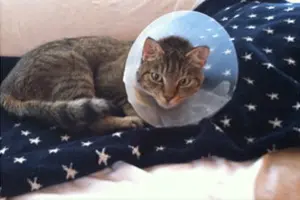
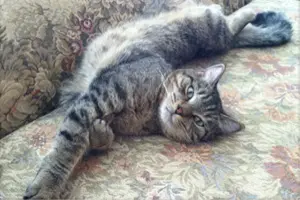
As Dr. Roman explains:
“Where do all the sexual hormones and growth factors come from? They come from the gut. If a very young animal is desexed and then also given antibiotics, those hormones are missing. The body needs all the precursors and building blocks to make the hormones and these probably come from the gut.”
Dr. Roman has raised four generations of standard Poodles and she currently has two generations running around. She uses the biome of the youngest ones who are still highly sexed in a system she calls “microbiome mixology,” which mixes the biomes of the younger, vigorous dogs with older dogs with cancer. The sick dogs given the mixture begin acting like puppies, and as Dr. Roman explains, “They’re getting the history of being able to fight the cancer.”
One of her dogs, Geneva, developed malignant breast cancer at age 7 and survived another 7.5 years.
Fecal Transplant Cures Poop Eating (Coprophagia)
Coprophagia, or poop eating, is a rather obnoxious behavior that no dog owner wants to see. However, what drives the behavior is probably the dog’s instinctive need for something his body is missing.
Another patient of Dr. Romans was a New England Assistance Dog Service (NEADS) dog, a beautiful Labrador who was bred and raised to be a service animal. However, because the dog would poop and then quickly eat it, he couldn’t be qualified as a service dog. He also had anxiety issues.
The dog’s owner had already started him on a raw diet, but he was still eating his poop. So Dr. Roman did some additional prepping of his gut with digestive enzymes and intestinal glandulars, then she did a fecal transplant with ozone and 24 hours later, he stopped the coprophagic behavior.
She has treated about four or five coprophagia cases, and in each case, the dog stopped eating poop, which is a 100% success rate! “These dogs were self -medicating and they needed to have a more complete biome to help bring their own biome into balance,” says Dr. Roman.
Preparing the ‘Landscape’ for a Successful Fecal Transplant
Since fecal transplants are an alternative therapy and something the majority of veterinarians probably haven’t even heard of, I asked Dr. Roman how pet owners can learn more about it. Can the transplants be given orally or intra-rectally?
Dr. Roman’s recommendation is to visit her website (and no, this is not a joke) Eat Sh*t & Live! (The subject is gross, let’s face it, so they needed a memorable name that also injected a bit of humor into the situation!) There you can find research articles from major US hospitals (e.g., Massachusetts General, Mayo Clinic, and Cedars Sinai) currently performing fecal transplants in humans. At Mass. General, for example, they’re using capsules.
The process Dr. Roman primarily uses involves an inexpensive everyday blender. She puts the poop in the blender with regular saline and blends it for a short time. Then it is filtered to extract any large pieces so that the mixture can be loaded into a syringe.
Next she administers rectal ozone to get rid of the gut biofilm, which is a sort of mucosal slime that grows on surfaces lining the gut and protects harmful bacteria.
After a few minutes, she takes the dog outside to poop to clear out the colon. Then she syringes the poop mixture, which is like liquid slurry, into the rectum, and massages the colon in an up and down motion to give the transplant an opportunity to “find its new home.”
Before any of this can happen, the dog’s gut has to be made suitable to accept the transplant. The dog must be eating a GMO-free, fresh raw diet. He must be given probiotics, perhaps colostrum, and nutraceuticals and glandulars that support gut health. Dr. Roman has learned that when the gut is prepared in this way, the fecal transplant works, and it works in one treatment.
There are some dogs that need repeated transplants due to certain health conditions, in particular dogs with an immunoglobulin deficiency. Their owners come by Dr. Roman’s clinic, pick up a bag of poop, taken it home, and keep it in the freezer. When their dog starts having an issue, they pop a piece of the frozen poop down the dog’s throat, and he gets better.
A GMO-free diet is important for successful fecal transplants. The genetically modified organisms or GMOs found in most commercial pet foods (e.g., GM corn, wheat, soybean) kill the microbiome. Glyphosate, the pesticide in GM crops, is designed to do just that.
Interest in Fecal Transplants Is Growing Worldwide
Despite the rather strange and gross nature of microbiome restorative therapy, Dr. Roman says it’s receiving wide acceptance both here and in other countries. In the US, fecal transplants to treat C. diff are widely accepted as being 97% effective in curing the infection. Dr. Roman is trying to encourage physicians to stop using vancomycin and metronidazole, and try ozone instead, because it stimulates the gut in a healthy way by supporting the mitochondria of the gut mucosal cells. It might even stimulate stem cells at the deepest level of the gut crypt vs. killing all the bacteria, bad and good, with antibiotics.
Dr. Roman has also shipped her dog’s biome to veterinarians in Dallas, Florida, Chicago, and California. She has vets overseas asking for it, but she’s not sure she can provide it to them legally at the moment. She has also opened a Fecal Bank that is shipping microbiome from her MASH clinic (www.mashvet.com).
To learn more, go to Eat Sh*t & Live. They are taking orders for those dogs and cats in need of supportive rebooting of their gut microbiome. Dr. Roman is treating all types of GI issues, including irritable bowel syndrome (IBS), C. diff, C. perfringens, and giardia, as well as kidney and liver issues, behavior, and cancer. Pets undergoing chemotherapy need to have their microbiomes re-established and nurtured.
Dr. Roman’s hope is to be able to establish a population of dogs in each area of the US that are clean fecal donors. She advises clients and veterinarians who call from other areas to look for naturally raised dogs in the local area who have been protected from toxins and vaccinations. The fecal donations of these animals can help dogs who have been over-treated with antibiotics and drugs. Dr. Roman has dogs in her practice that have been through 20 courses of antibiotics. No biome can remain healthy under those circumstances.
Many thanks to Dr. Margo Roman for chatting with me today, and for providing a natural, common sense, and basically free therapy for sick pets. Again, if you want to learn more about microbiome restorative therapy and Dr. Roman’s work, visit her website Eat Sh*t & Live.











